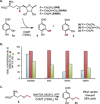Effects of Active-Site Modification and Quaternary Structure on the Regioselectivity of Catechol-O-Methyltransferase
- PMID: 26797714
- PMCID: PMC4770447
- DOI: 10.1002/anie.201508287
Effects of Active-Site Modification and Quaternary Structure on the Regioselectivity of Catechol-O-Methyltransferase
Abstract
Catechol-O-methyltransferase (COMT), an important therapeutic target in the treatment of Parkinson's disease, is also being developed for biocatalytic processes, including vanillin production, although lack of regioselectivity has precluded its more widespread application. By using structural and mechanistic information, regiocomplementary COMT variants were engineered that deliver either meta- or para-methylated catechols. X-ray crystallography further revealed how the active-site residues and quaternary structure govern regioselectivity. Finally, analogues of AdoMet are accepted by the regiocomplementary COMT mutants and can be used to prepare alkylated catechols, including ethyl vanillin.
Keywords: biocatalysis; enzyme structure; methyltransferases; protein engineering; regioselectivity.
© 2015 The Authors. Published by Wiley-VCH Verlag GmbH & Co. KGaA.
Figures




Similar articles
-
Detoxication of structurally diverse polycyclic aromatic hydrocarbon (PAH) o-quinones by human recombinant catechol-O-methyltransferase (COMT) via O-methylation of PAH catechols.J Biol Chem. 2011 Jul 22;286(29):25644-54. doi: 10.1074/jbc.M111.240739. Epub 2011 May 27. J Biol Chem. 2011. PMID: 21622560 Free PMC article.
-
Comparative study of ortho- and meta-nitrated inhibitors of catechol-O-methyltransferase: interactions with the active site and regioselectivity of O-methylation.Mol Pharmacol. 2006 Jul;70(1):143-53. doi: 10.1124/mol.106.023119. Epub 2006 Apr 17. Mol Pharmacol. 2006. PMID: 16618795
-
Crystal structures of the apo and holo form of rat catechol-O-methyltransferase.J Struct Biol. 2009 Mar;165(3):133-9. doi: 10.1016/j.jsb.2008.11.012. Epub 2008 Dec 10. J Struct Biol. 2009. PMID: 19111934
-
Structure-based drug design of catechol-O-methyltransferase inhibitors for CNS disorders.Br J Clin Pharmacol. 2014 Mar;77(3):410-20. doi: 10.1111/bcp.12169. Br J Clin Pharmacol. 2014. PMID: 23713800 Free PMC article. Review.
-
Unveiling the biopathway for the design of novel COMT inhibitors.Drug Discov Today. 2022 Oct;27(10):103328. doi: 10.1016/j.drudis.2022.07.013. Epub 2022 Jul 27. Drug Discov Today. 2022. PMID: 35907613 Review.
Cited by
-
Enzymatic Generation of Double-Modified AdoMet Analogues and Their Application in Cascade Reactions with Different Methyltransferases.Chembiochem. 2022 Dec 16;23(24):e202200511. doi: 10.1002/cbic.202200511. Epub 2022 Nov 18. Chembiochem. 2022. PMID: 36288101 Free PMC article.
-
From Natural Methylation to Versatile Alkylations Using Halide Methyltransferases.Chembiochem. 2021 Aug 17;22(16):2584-2590. doi: 10.1002/cbic.202100153. Epub 2021 May 10. Chembiochem. 2021. PMID: 33890381 Free PMC article. Review.
-
Methyltransferases: Functions and Applications.Chembiochem. 2022 Sep 16;23(18):e202200212. doi: 10.1002/cbic.202200212. Epub 2022 Jul 5. Chembiochem. 2022. PMID: 35691829 Free PMC article. Review.
-
New Trends and Future Opportunities in the Enzymatic Formation of C-C, C-N, and C-O bonds.Chembiochem. 2022 Mar 18;23(6):e202100464. doi: 10.1002/cbic.202100464. Epub 2021 Nov 24. Chembiochem. 2022. PMID: 34726813 Free PMC article. Review.
-
ICBS 2017 in Shanghai-Illuminating Life with Chemical Innovation.ACS Chem Biol. 2018 May 18;13(5):1111-1122. doi: 10.1021/acschembio.8b00220. Epub 2018 May 2. ACS Chem Biol. 2018. PMID: 29677443 Free PMC article. No abstract available.
References
-
- None
-
- Bornscheuer U. T., Huisman G. W., Kazlauskas R. J., Lutz S., Moore J. C., Robins K., Nature 2012, 485, 185–194; - PubMed
-
- Jaeger K. E., Eggert T., Curr. Opin. Biotechnol. 2004, 15, 305–313; - PubMed
-
- Patel R. N., ACS Catal. 2011, 1, 1056–1074;
-
- Reetz M. T., J. Am. Chem. Soc. 2013, 135, 12480–12496; - PubMed
Publication types
MeSH terms
Substances
Grants and funding
LinkOut - more resources
Full Text Sources
Other Literature Sources
Miscellaneous

